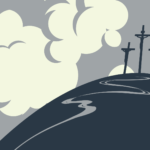The Uniting Church in Australia has a proud history in the defence forces: it provided the first three female chaplains to enter the Air Force, Navy and Army. LYNDAL IRONS spoke to two of the trio to find out what it has been like to break that ground.
As the Australian Defence Forces’ first female chaplain, the Rev. Wendy Snook was memorable to many during her five-year placement with the Air Force. A lot of heads turned for a second look at the cross on her shoulder as she paced Pearce Airbase in Western Australia.
Alongside pilots, commanders and RAAF families who say their conversations with her were valuable, she jokingly says it’s the tailoring department who will remember her most.
“I rocked up at Pearce Airbase but they didn’t know what to do for a uniform for me,” she remembers.
“They gave me a women doctor’s uniform and changed the symbol on the shoulders. They had to invent the first maternity chaplain’s uniform for me too. I got to know them well!”
Wendy took up the position in 1991 — a time when female ordination was a hot ecumenical topic in the lead up to the first female Anglican priests’ ordination in 1992.
While the proposition of a female chaplain raised some eyebrows in the Religious Advisory Committee to the Services (RACS), strong support from both the Uniting Church and the Australian Defence Force (ADF) — coupled with a compatible skill set in work and ministry — made Wendy a candidate that was hard to refuse.
“Not every man is suited to ADF chaplaincy. Neither is every woman. But I thought I could do it,” she said.
In her second year out of university, Wendy was part of Rio Tinto’s exploration geology team that discovered one of the world’s biggest diamond mines in Western Australia.
The job familiarised her with aviation, navigation and adventure. After answering the call to ministry, she was excited to discover another role that combined some of the traits of her previous work.
For Wendy, breaking ground for female chaplains was partly a matter of principle, but there were practical reasons for including women too.
“The Uniting Church ordains women — that’s a big thing for us,” she said.
“I wanted to support the right of women in all churches to be able to minister.
“Secondly, there are women in the ADF and they need chaplaincy and support as much as men. While I don’t doubt that men can be chaplains to women, we all know that men and women sometimes talk to each other differently to the way they do when there are just females around.”
Rich spiritual environment
For the Rev. Christine Senini, the Royal Australian Navy’s (RAN) first female chaplain (Permanent Navy), the greater the diversity of chaplains available, the better the choice available for everyone.
“I think that having women in defence force chaplaincy is really important,” she said.
“Men aren’t better or worse than women. They are just different. There are a lot of people who are comfortable with both genders but if they had a choice, they’d prefer to go to a female.
“The other point is, why not? The Navy has been very embracing of that. The average sailor is very positive about that.”
In the restrictive lifestyle at sea, her gender is only one point of difference to contend with in ministry.
As the sole religious authority on board she typically ministers to 200 people of all faiths, denominations: an ecumenical mix that requires sensitivity when conducting the weekly service.
But largely, like society ashore, the ship’s population is secular — a condition that makes for a surprisingly rich spiritual environment.
She claims to have had more “faith” conversations with people in the Navy than during her time as a minister in congregations.
“On land, most of these people would not wake up in the morning and say, ‘I’m upset about something; I’ll go to the local church, knock on the door and ask for help.’
“It just wouldn’t be an idea about how to deal with it. But they will, particularly on a ship, wake up and think, ‘I’ll just go speak with the chaplain’ because it is less daunting. And it’s also a big part of my job to walk into their spaces and check in on how they are doing that day.”
Christine sees her primary responsibility as offering pastoral care: “To hold the hurts, to preserve the hopes, to name the fears and articulate the dreams” of those in her care.
Chaplains may also liaise with RAN families, advocate on behalf of crew members, scatter the ashes of veterans at sea and preside over services and ceremonies.
Christine said the pressures of life are amplified at sea: the lack of privacy, close quarters, long or disjointed working hours and separation from family and loved ones mean that many people lean on her for support in building life skills.
Questions about loneliness and grief often lead to larger questions about meaning and faith.
Christine quickly earned the title “Action Chaplain”: Where permitted, she works alongside RAN sailors in the engine room, cleaning and painting or keeping them company during arduous tasks.
While sailors are attached to a ship and experience time “on” and “off”, depending on activity, chaplains can skip between ships, only returning to shore for a few weeks of the year, for years at a time.
“It is intense,” she said, “but it is the nature of our role. Doctors work the same way.
“What makes it worthwhile is the precious gift that I’m given when I am on a ship, when I’m allowed to be involved in people’s lives. To share with them how valuable they are to God. Some of that is in conversation but a lot of it is just being there.”
Church afloat
On a ship, a healthy chapel attendance averages at around 10 per cent of the crew. At any time, a third is working, a third is sleeping and, of the remainder, not many are likely to turn up to church on land.
But that doesn’t always stop them coming.
“If there’s 200, 20 people is pretty good. On my last ship I was averaging 45. And I’d say around half or maybe more of those people had never been to church in their life and wouldn’t have had parents who had gone to church. But for some reason they felt valued, safe.
“They felt it was a time they could reflect and connect with something different in their lives. They might not express it in ‘faith terms’ but mostly they would.
“Being on a ship with them for the whole week means it isn’t just about 20 minutes or an hour on Sunday.”
The tougher it gets on board the more Christine feels able to contribute. So trips like the one to the Middle East in 2008-09 to protect oil platforms for Iraq are some of her most memorable moments in service.
Wendy Snook, too, has carried away valuable memories out of reach of most civilians: lingering in the parachute towers in winter where warm air animated them into giant jellyfish and, most precious, the day she went “cloud surfing” and doing barrel rolls in a PC-9 training session.
Alongside the uplifting ceremonial roles in worship, graduations parades, presentations and open days, chaplains in the RAAF help with the solemn jobs of informing the next of kin when a member dies, pastorally caring for the family involved and helping to organise the funeral.
In daily life at the base, jobs from parachute packer to pilot come attached with huge responsibility and consequences.
“If anyone makes a mistake it can mean somebody else’s life,” said Wendy.
Wendy’s proud of her five years as an RAAF chaplain.
“We’ve made it easier for women in other churches now who feel they can contribute in this way.”
Christine is the only woman who currently serves as a chaplain in the RAN. She’d like to see more.
“It’s been a real honour to be on this journey,” she said.
“Although it isn’t a Christian group per se on a ship — the way we work together, live together — it’s an authentic, really genuine ministry.”
Lyndal Irons











